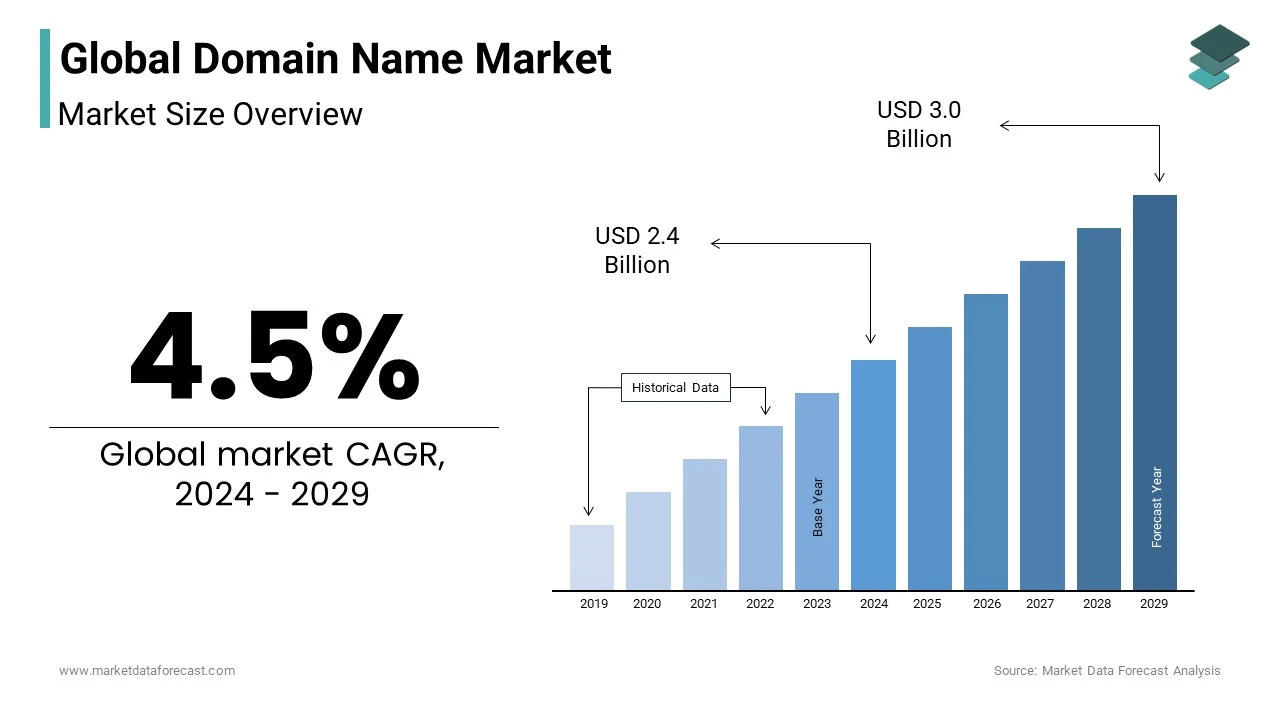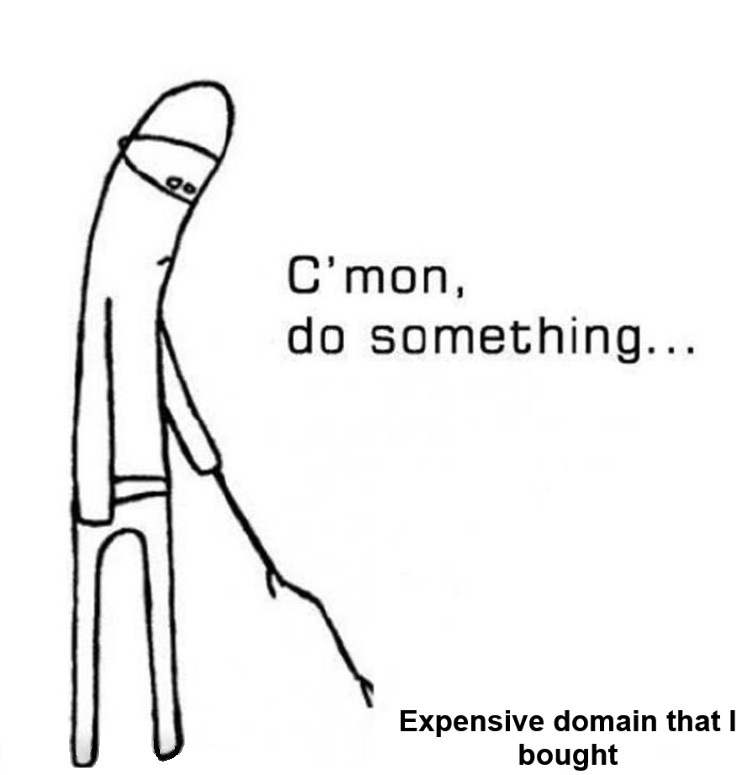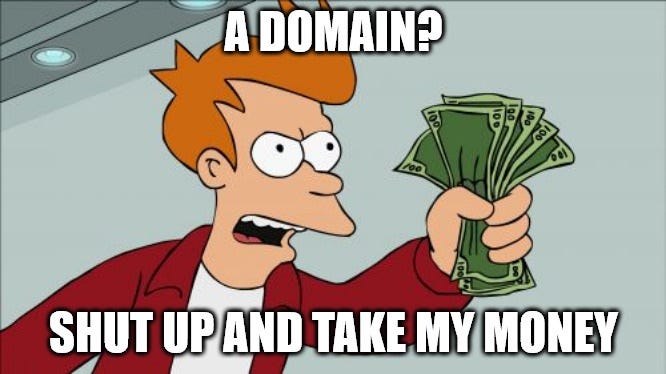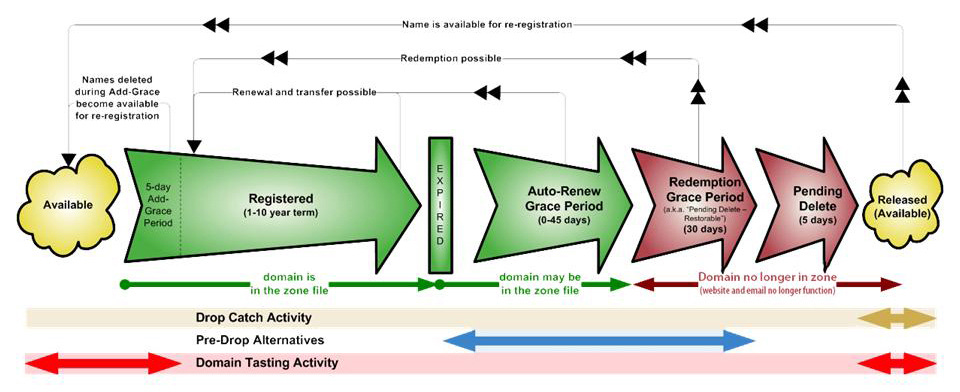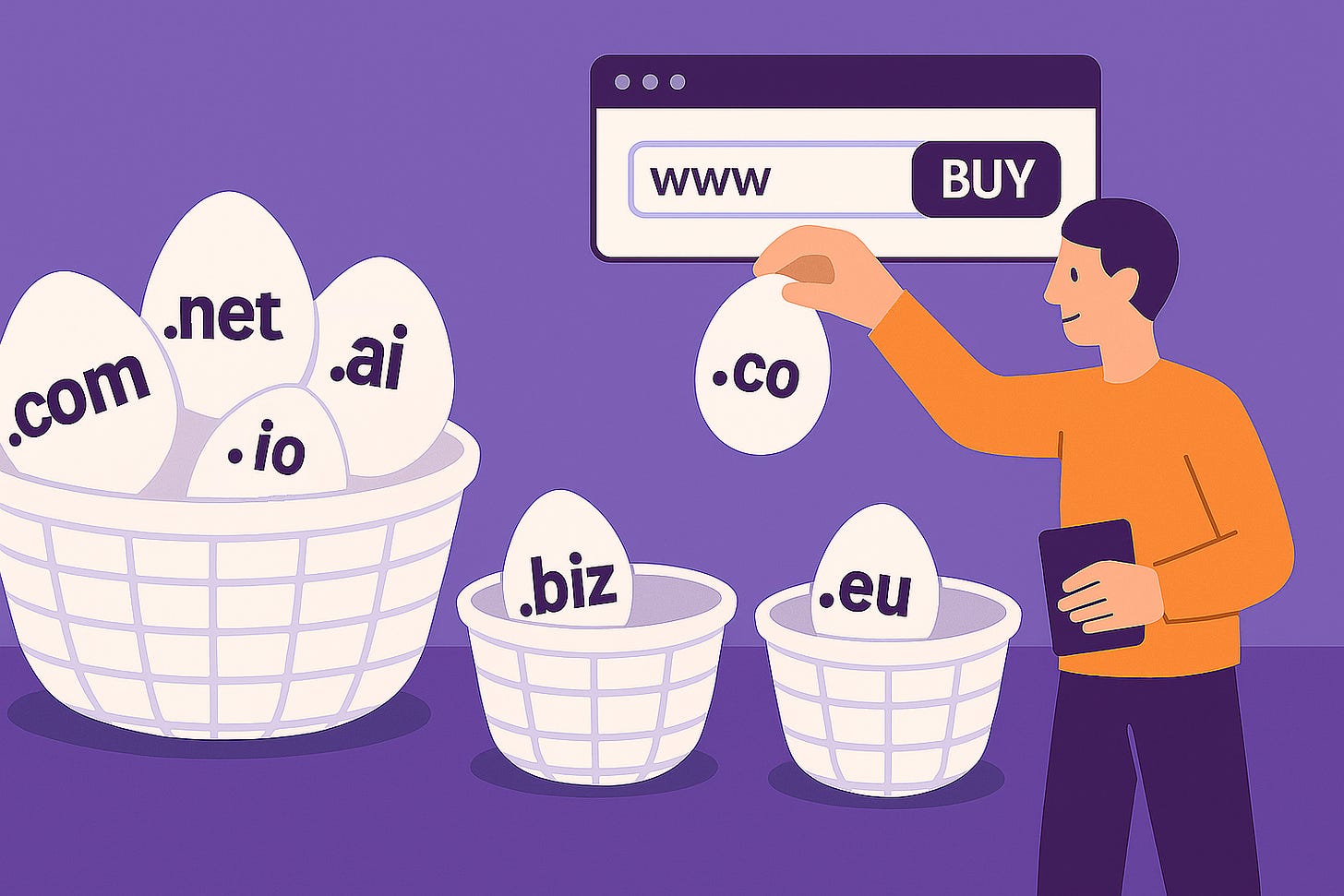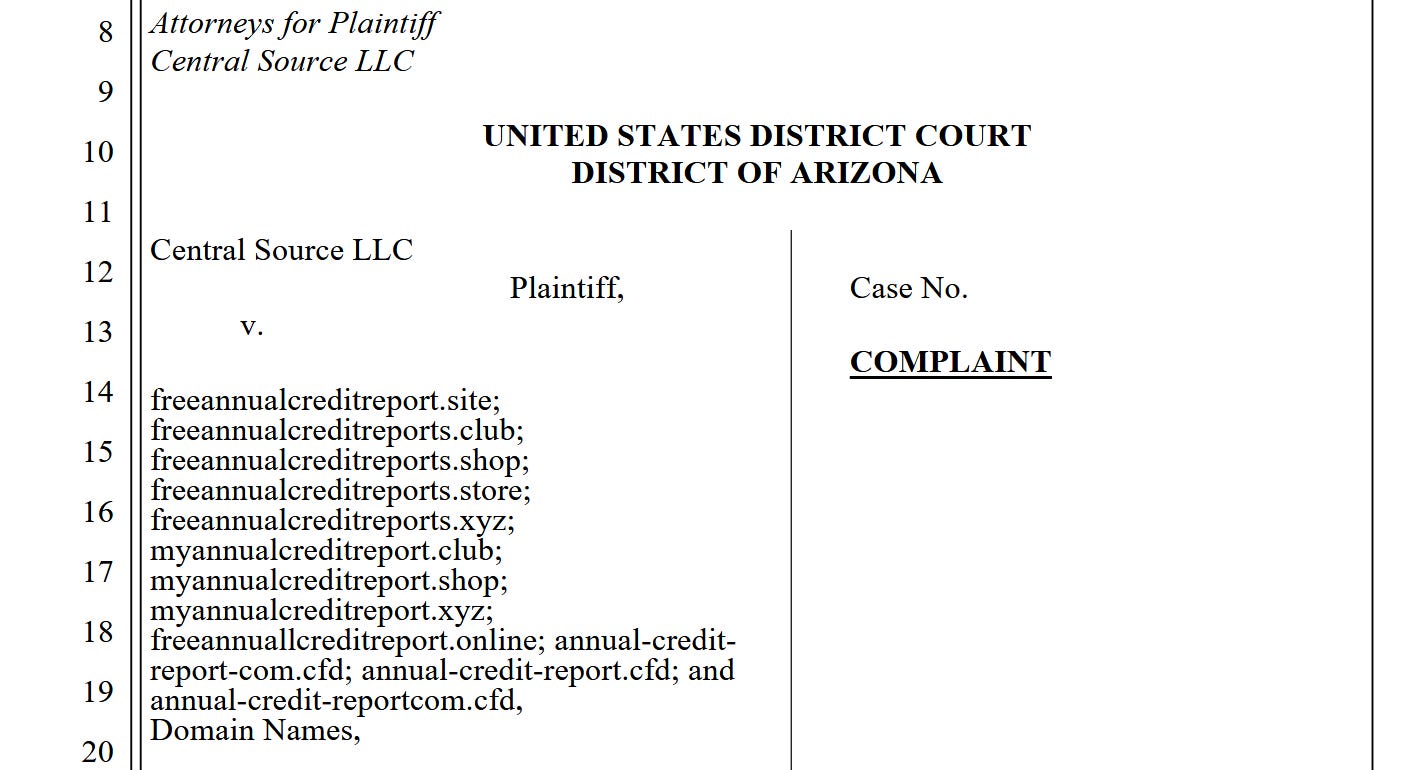The Ultimate No-Fluff Guide to Domain Flipping (2025 Edition)
How the domain flipping business really works, what to avoid, and how to start without burning cash.
Introduction
The golden age of domain buying is long gone. The best time to grab a valuable domain was 30 years ago. Today, nearly every good domain is taken - and the entire game revolves around expired domains, auctions, and taking risk.
For most, it’s more of a hobby, than a stable business. But it doesn’t mean it’s impossible to earn from it.
Most domain flipping guides will tell you to “find an expired domain, list it on a marketplace, and wait.” Or worse - they'll suggest using ChatGPT to brainstorm names and hope something sticks.
But that’s not how it works.
In reality, domain flipping in 2025 is more like a slow-moving gamble than a stable business. It requires capital, research, patience, and a lot of trial and error. Most people who try it lose money.
Still, the global domain name market surpassed $2.4 billion in 2024, and it's expected to grow to $3 billion by 2029.
So yes - there’s money in reselling domains.
And with the right approach, it’s possible to make some profit - or at least avoid major losses. That’s what this guide is about.
I wrote this as a complete, honest breakdown of the domain flipping world. No fluff, no generic advice. Just what actually works, what doesn’t, and what I’ve learned by trying it myself.
This is the part 1 of a guide that covers:
The history and mechanics of domain flipping
The risks no one talks about
Tools and platforms you’ll need
A step-by-step process to find and evaluate domains
Selling strategies (including cold outreach and pricing)
Why most people fail at it
If you’re serious about learning domain flipping - or just curious how this works - this guide is for you.
History of Domain Flipping
Early Days
The story of domain flipping begins with the birth of the internet itself. The first domain name ever registered was symbolics.com, on March 15, 1985, by a computer manufacturer in Massachusetts.
This was followed by other early registrations, mostly by tech companies and universities. (Here are the first 100 domains registered if you’re curious.)
Back then, domain names weren’t considered valuable assets. There was no scarcity, no structured marketplace, and many untaken domain names available.
Anyone could register a domain for free or for a small fee, and thousands of domains in today’s market considered being valuable, remained unregistered for years.
In 1995, domain names officially stopped being free. Network Solutions, under a government contract, began charging $100 for a two-year registration. This moment marked the transition from domains treated as labels to potential commercial assets.
The Dot-Com Boom
The domain aftermarket exploded during the late 1990s.
The first major sale happened in 1999, when business.com was sold for $7.5 million. That was an unheard of amount for that time. What’s interesting, in 2007 it was resold for $350 million. (To be fair, by then it was a business generating $15M/year in revenue.)
Other notable domain sales from that era:
Altavista.com – $3.3 million (1998)
Loans.com – $3 million (2000)
Wine.com – $2.9 million (1999)
After the Dot-Com Crash (2000s–2010s)
This is when the domain flipping business gained more traction and many hobbyists started doing this as a hustle, with some companies treating that as a serious business.
Platforms like:
Afternic (founded in 1999)
Sedo (founded in 2001)
GoDaddy Auctions
... helped structure and scale the domain resale business.
The flipping model became clear:
Acquire undervalued domains
Hold or "park" them (some generated ad revenue)
Resell at profit
Rinse and repeat
Over time, short, brandable, and one-word .com domains became increasingly rare and valuable. Hundreds of alternative extensions (.net, .org, .io, .xyz, .club, .ai) launched - but .com remained king.
How Domain Flipping Works
Domain flipping is simple in theory: buy a domain, hold it, sell it for more. But the mechanics behind it are a bit more complex - and risky.
Two Primary Ways to Acquire Domains
Registering fresh, unclaimed domains
You brainstorm names that haven’t been registered yet and buy them at the base price (typically $10–$20). This is high-risk and high-effort - because chances are, anything good is already taken.Drop-catching expired domains
Domains that someone else once owned but failed to renew go through an expiration process. If they aren't recovered, they’re released to the public - and that’s when flippers try to grab them.
What Happens When a Domain Expires
The expiration process has several stages:
Auto-Renew Grace Period (0–30 days): The original owner can still renew at the normal price.
Redemption Grace Period (30–60 days): The owner can still get it back, but must pay a hefty fee.
Pending Delete Phase (final 5 days): The domain is locked, awaiting deletion.
Dropped and Released: Anyone can now attempt to register it - this is when drop-catchers take action.
Drop-catching can be competitive. Specialized services (like SnapNames or DropCatch) race to grab the domain the second it becomes available.
Why It's Like Gambling
Here’s the brutal truth: only a small percentage of domains ever sell.
You might register 100, and none move for years. Meanwhile, each domain costs $10–$20/year to keep.
To break even, you’d need at least one solid sale to cover:
Acquisition and renewal costs
Platform fees (Sedo, GoDaddy, etc.)
Taxes (platform + local)
Your time and effort
Domain flipping isn’t “buy and forget.” It’s a game of holding costs, liquidity risk, and timing.
Diversify or Die
The most common rookie mistake? Going all-in on one niche, one trend, or one type of domain.
If that trend slows down, you’ll be stuck with domains that no one want.
The key is not to put all eggs into one basket.
Just like investing in stocks or startups, you need to place your bets across multiple areas:
Different niches: Tech, health, crypto, gaming, SaaS, finance, lifestyle, etc.
Different types: Brandables, SEO-aged domains, expired domains.
Different lengths and styles: Short vs. descriptive, keyword-rich vs. abstract.
Patience is a Mandatory
Domain flipping is not a fast hustle.
If you're looking for quick returns, you're going to hate this business.
On NamePros (the biggest domain flipping forum), patience was voted the #1 most important trait in a poll among flippers.
You might buy a domain today... and not get a single offer for 2–3 years.
That doesn’t mean it was a bad purchase. It just means the right buyer hasn’t come along yet.
It’s not like selling shoes or electronics — demand is highly specific and extremely time-sensitive. A domain can be worthless one month and suddenly in-demand the next.
This is why most successful flippers treat it like:
A long game
A side hustle
Or even a digital investment portfolio
They’re not sitting at their desk refreshing GoDaddy listings, hoping for an instant sale. They buy, hold, and occasionally make a sale.
This is slow, strategic, and sometimes frustrating work - and you’ll need to be okay with that.
Common Challenges and Risks
Domain flipping has a shiny appeal - low overhead, big potential wins. But the reality? There are plenty of room for errors learning opportunities. Here are the most common pitfalls that cost a lot in the long run.
Renewal Fees Add Up
Holding a domain isn’t free. You’ll pay $10–$20 per year (or more) just to keep each name.
Now multiply that by 50 or 100 domains.
💡 100 domains × $12 = $1,200/year just to keep them alive.
If you're not making consistent sales, those costs pile up fast. And when renewals hit, you're forced to choose which domains to keep - and which to let go.
Low Liquidity
Even premium domains often sit unsold for years. This isn’t eBay. Most of the time, a domain sells when:
A business rebrands
Someone starts a new project
A startup raises funding
A buyer suddenly wants your exact name
That’s it. If none of those conditions hit — it just sits.
You’re not just betting on value. You’re betting on timing.
False Sense of Value
Just because a domain "sounds good" or GoDaddy appraises it at $5,000 doesn’t mean anyone will buy it.
Appraisals are based on keyword matching and past sales - not actual market demand. And some sellers let their imagination run wild.
Real example - odentrepreneur.com domain listed for sale:
The domain name contains 'entrepreneur,' which is a premium keyword, but to my knowledge, these first two 'od' letters in this domain name do not have any associations with the following 'entrepreneur.' And the fact that a similar domain, ogentrepreneur.com, is free and can be registered for the standard price of $10-$20, makes the price the seller expects ($3895 USD) absurd.
The second example is lifebehindthewall.com. It does sound cool and could be a strong brand for someone creating content about living abroad.
But there are a few reasons why the seller's valuation feels off:
Variations like
.org,.net, and other TLDs are still availableA shorter version - lifebehindwall.com - is completely unregistered
While it’s a great fit for a personal blog or even a book title, it’s not the type of domain businesses are actively looking to buy. It doesn’t fall into the “business” category of domains that companies usually pay a premium for.
A solo blogger - the most likely audience for this domain - probably wouldn’t spend top dollar when they could easily come up with a dozen other brandable alternatives for much less.
Trademark and Legal Risks
You can’t just register anything that sounds “brandable.” If it overlaps with a trademark, you’re in trouble.
Even if unintentional, you could face:
UDRP complaints (Uniform Domain-Name Dispute-Resolution Policy)
Domain forfeiture
Legal threats or lawsuits
Example: Registering something like
faceb00k-apps.comis a guaranteed way to get hit with a UDRP case.
A recent example involved a domain that mimicked the Annual Credit Report brand — the registrant was sued for cybersquatting.
Platform Fees and Taxes
Selling on Sedo, Flippa, or GoDaddy means paying commissions. For example:
Sedo takes ~15%–20% depending on domain and sale method
Flippa charges an upfront listing fee (starting at $49) plus a success fee
Add payment processing fees and VAT or local income tax, and your profit can shrink fast.
Crowded Market
Everyone is chasing the same handful of trends. You’re not the only one thinking “AI is hot right now.” That means more competition for drop-catching, higher auction prices, and more junk flooding the marketplaces.
Wrapping Up
By now, you should have a clear idea of how domain flipping really works - including the risks most people won’t tell you about.
The market’s crowded, it’s easy to lose money, and buying random domains rarely works. But with the right mindset (and some patience), it can be a surprisingly rewarding side hustle.
In Part 2, I’ll break down the step-by-step playbook:
How to spot valuable domains before others do
Tools I personally use (free and paid)
My real-world process for evaluating names
Selling strategies - including cold outreach and how to price domains
Part 2 - coming soon


